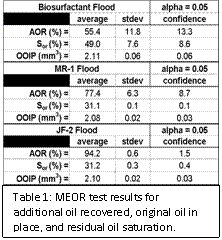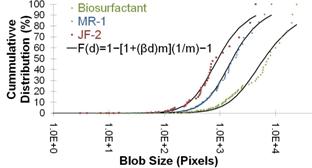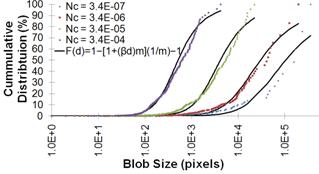AmericanChemicalSociety.com
Reports: AC9 48505-AC9: Biosurfactant Enhanced Oil Recovery: A Pore-Scale Investigation of Interfacial and Microbial Interactions
Dorthe Wildenschild, Oregon State University
Microbially enhanced oil recovery (MEOR) has historically been a technology marketed to industry with promises of increased tertiary oil recovery at a fraction of the price of other enhanced oil recovery processes (EOR), however to this point, increased oil production has been at best inconsistent and results of laboratory and field scale experiments and implementations have been conflicting.
The proposed work uses fundamental research approaches to evaluate MEOR technology, specifically using in-situ microbially produced biosurfactants. The research combines a novel 3D pore-scale imaging technique (high-resolution computed microtomography, CMT), 2D micro-model work to improve understanding of the microbial and interfacial interactions at a very basic level. The focus of the proposed study is (1) effects of pore size, and pore-size distribution (to evaluate the effect of residual oil morphology and pore space geometry and thus tortuosity on mobilization), (2) effects of biosurfactant production on the wettability of the system and thus oil recovery rates, and (3) effects of inherent reservoir wettability on the effectiveness of biosurfactant-facilitated MEOR.
Research during the second year has focused on (1) decoupling the mechanisms of MEOR using 2D micromodel studies, specifically the biosurfactant production and bioclogging mechanisms (2) fabrication of designer-wet micromodels to allow for assessment of the effect of wettability on recovery, and (3) preparation for high-resolution tomographic imaging in 3D flow columns at the Advanced Photon Source in November 2010. These experiments will address changes in recovery due to wettability and a second run early in 2011 will be designed to assess pore morphology effects on recovery. The period of research activity by the graduate student researcher was 8 months during this second year.
(1) Decoupling the mechanisms of MEOR using 2D micromodel studies, specifically the biosurfactant production and bioclogging mechanisms
Several experiments were designed to decouple the MEOR mechanisms of biosurfactant production and bioclogging within water-wet micromodels (Figure 1), using Shewanella oneidensis MR-1, a biofilm forming aerobe and Bacillus mojavensis JF-2, which is known to produce biosurfactant and also forms biofilm.
 The following micromodel
MEOR tests were conducted and visualized with a stereomicroscope to give
insight into the mechanisms allowing for increased oil recovery:
The following micromodel
MEOR tests were conducted and visualized with a stereomicroscope to give
insight into the mechanisms allowing for increased oil recovery:
Test (1) Extracted biosurfactant from B. mojavensis JF-2 – exploring only the effects of biosurfactant
Test (2) S. oneidensis MR-1 – exploring the effects of bioclogging due to biofilm growth, only
Test (3) B. mojavensis JF-2 – exploring the combined effect of biosurfactant and bioclogging
Experiments were conducted at a flow rate of 2.7 m/day, the two phases were Soltrol 220 and brine-based growth media with a resulting interfacial tension of 17 dynes/cm. Test 3 (i.e. bioclogging and biosurfactant production) showed improved recovery compared to Test 2 (i.e. only bioclogging), suggesting that biosurfactant production aided in additional recovery. Thus, overall, bioclogging was more effective than biosurfactant flooding and improved recovery resulted when bioclogging and biosurfactant production occurred simultaneously, see Table 1.
 However, the biofilm formed by the two
organisms was structurally somewhat different and B. mojavensis
may form a biofilm that is more effective in terms of oil recovery due to
clogging than S. oneidensis. The biosurfactant flooding solution for Test 1 was prepared to
match the IFT of Test 3, but the resulting recovery was lower than Test 3.
However, the biofilm formed by the two
organisms was structurally somewhat different and B. mojavensis
may form a biofilm that is more effective in terms of oil recovery due to
clogging than S. oneidensis. The biosurfactant flooding solution for Test 1 was prepared to
match the IFT of Test 3, but the resulting recovery was lower than Test 3.
Image analysis also allowed for measurement of residual oil blob size and radius of curvature distributions (BSD & RCD) for all tests. MEOR resulted in oil blob size and radius of curvature distributions similar to those obtained by an abiotic capillary desaturation test, where the flooding rate was increased post primary recovery.
Furthermore, calculated capillary numbers during MEOR flooding with biofilm formation produced lower residual oil saturation than the corresponding capillary number under abiotic conditions; suggesting that bioclogging is a potentially effective mechanism for flow alteration, and thus pore morphology modification, within porous media and has the ability to significantly affect oil recovery beyond that predicted by capillary number.
Figure
2: Blob size distributions for the MEOR and capillary desaturation
experiments (2) Fabrication of designer-wet micromodels to allow for assessment of the effect of wettability on recovery To evaluate the effect of altered wettability on recovery rates, we have
started manufacturing designer-wet 2D micromodels using a wetting phase mask
that excludes the thereby covered micromodel area from being affected during
subsequent OTS (octadecyltrichlorosilane) treatment, see
Figure 3. Once the mask material is removed after OTS treatment, a fraction of
the micromodel is water-wet and a fraction is
oil-wet. We plan to manufacture micromodels with
varying oil-wet to water-wet fractions of surface to assess the effect of wettability on oil recovery. Figure 3: Micromodel gelatin mask (left) and UV-died OTS solution
during OTS treatment (right) (3) Preparation for high-resolution tomographic imaging in 3D flow columns at the Advanced
Photon Source, Argonne National Laboratory These three-dimensional
experiments (to be carried out in Nov 2010) will address changes in recovery
due to wettability and a second run early in 2011
will be designed to assess pore morphology effects on recovery. A hurdle is the
accurate delineation of the oil-wet vs water-wet bead
fractions, such that the local impact of wettability on
the recovery process can be evaluated. Using above-and-below the photoelectric
edge imaging, it is possible to clearly distinguish the different fluid phases
and accurately calculate actual recovery as a function of degree of wettability alteration in the system.


Copyright © American Chemical Society



